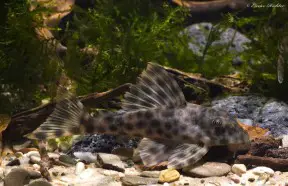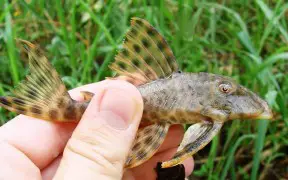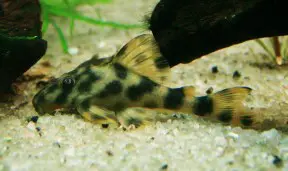Peckoltia oligospila
L006, Brown Dot Peckoltia
SynonymsTop ↑
Chaetostomus oligospilus Günther, 1864
Etymology
Peckoltia: named for German botanist and pharmacist Gustavo Peckolt who was born in Brazil, became a member of the Natural History Commission of Rondon, and published important books about Brazilian plants in the late 1800s alongside his father Theodor.
oligospila: from the Greek ολιγος (oligos), meaning ‘small, few’, and σπίλος (spilos), meaning ‘spot, dot’.
Classification
Order: Siluriformes Family: Loricariidae
Distribution
This species is known from the rios Tocantins and Capim in Tocantins and Pará states, Brazil including a number of their tributaries.
Type locality is given as ‘Rio Capin, Pará State, Brazil’, which appears to correspond to the rio Capim, a short tributary of the lower Amazon which joins the latter near its mouth.
Maximum Standard Length
90 – 100 mm.
Aquarium SizeTop ↑
An aquarium with base dimensions of 120 ∗ 30 cm or equivalent should be the smallest considered.
Maintenance
Not difficult to maintain under the correct conditions; we strongly recommend keeping it in a tank designed to simulate a flowing stream with a substrate of variably-sized rocks, sand, fine gravel, and some water-worn boulders.
This can be further furnished with driftwood branches, terracotta pipes, plant pots, etc., arranged to form a network of nooks, crannies, and shaded spots, thus providing broken lines of sight.
Water Conditions
Temperature: 24 – 30 °C
pH: 5.5 – 7.5
Hardness: 36 – 268 ppm
Diet
Wild specimens are likely omnivorous but with a preference for aquatic invertebrates and suchlike.
In the aquarium it does best when offered a varied diet comprising sinking dried foods, frozen Daphnia, mosquito larvae, chironomid larvae (bloodworm), and prawn/shrimp, for, example, plus some fresh fruit, parboiled potato, etc.
Home-made foods using a mixture of natural ingredients bound with gelatin are very useful since they can be tailored to contain fresh vegetables, Spirulina and meatier ingredients.
Behaviour and CompatibilityTop ↑
Relatively peaceful but territorial with conspecifics and similarly-shaped species.
Sexual Dimorphism
Adult males possess a series of odontodes on the caudal peduncle and opercle.
Sexually mature males are also more slender and less stocky than females, a difference which is easily observed when the fish are viewed from above.
Reproduction
Cave-spawner with the male responsible for brood care.
NotesTop ↑
This species can be distinguished from all congeners except P. bachi and some specimens of P. furcata by possessing only faint spots and saddles on the body.
It can be told apart from P. bachi by possession of narrow (vs. wide) pelvic-fin spines, having the eyes positioned high (vs. low) on the head, and distinctly round (vs. appearing more as a mottling) spots on the body.
It differs from P. furcata by presence (vs. absence) of spots on the abdomen of larger juveniles and adults and by the spots in the caudal fin being separate from one another (vs. combining to form bands).
Peckoltia lineola also has spots on the head but differs from P. oligospila in possessing bands (vs. spots) in all fins (vs. bands in all fins) and vermiculations on the head formed by combinations of spots (vs. spots always distinct).
References
- Günther, A., 1864 - Catalogue of the Fishes in the British Museum v. 5: i-xxii + 1-455
Catalogue of the Physostomi, containing the families Siluridae, Characinidae, Haplochitonidae, Sternoptychidae, Scopelidae, Stomiatidae in the collection of the British Museum. - Armbruster, J. W., 2008 - Zootaxa 1822: 1-76
The genus Peckoltia with the description of two new species and a reanalysis of the phylogeny of the genera of the Hypostominae (Siluriformes: Loricariidae). - Ferraris, C. J., Jr., 2007 - Zootaxa 1418: 1-628
Checklist of catfishes, recent and fossil (Osteichthyes: Siluriformes), and catalogue of siluriform primary types. - Reis, R. E. , S. O. Kullander and C. J. Ferraris, Jr. (eds), 2003 - EDIPUCRS, Porto Alegre: i-xi + 1-729
Check list of the freshwater fishes of South and Central America. CLOFFSCA. - Stawikowski, R., A. Werner and I. Seidel, 2004 - DATZ: 1-132
DATZ Special: L-Numbers.




